These Fertilizer Spreaders Make Short Work of Nourishing Your Lawn and Garden

"Hearst Magazines and Yahoo may earn commission or revenue on some items through these links."
If you want to grow a lush and verdant lawn that earns the envy of your neighbors, you need to go beyond simply planting grass. Either you can hire a lawn service to care for it, or you have to put in the hard work of reseeding each Fall and keeping it well-nourished all year.
If you take the DIY route, you’ll need a good fertilizer spreader, which helps you distribute seeds, weed control, and fertilizer across your yard quickly and evenly. They come in a variety of shapes and sizes, including small handheld models for garden beds and decorative patches, push spreaders for the average homeowner, and heavy-duty tow-behind models to cover large fields.
Regardless of how much ground you have to cover, though, the best fertilizer spreaders help make sure that all your hard work pays off, and you get a thick, healthy lawn this season.
The Best Fertilizer Spreaders
Best Overall: Scotts Turf Builder EdgeGuard DLX
Best Value: Scotts Turf Builder EdgeGuard Mini
Best for Large Yards: Chapin 80-Pound Professional Turf Spreader
Best Drop Spreader: Scotts Turf Builder Classic Drop Spreader
Best Twin-Rotor Spreader: Scotts Elite Spreader
The Expert: I’m a freelance writer who covers home improvement, including power tools, lawn care and yard machines. I’ve written hundreds of stories, covering everything from riding lawn mowers to the best cordless drills for a wide array of publications including Popular Mechanics, Bob Vila, Pro Tool Reviews, Popular Science, and CNN Underscored. As someone who’s serious about keeping up with the Joneses when it comes to his lawn, I break out my fertilizer spreader every year to keep my lawn growing thick and green.
What to Consider
Types of Fertilizer Spreaders
Roughly speaking, fertilizer spreaders fall into one of three categories–broadcast spreaders, drop spreaders, and handhelds. Like its winter weather twin, the salt spreader, the right fertilizer spreader for any specific job largely depends on the size of the yard or field you plan to fertilize.
Broadcast spreaders get their name from the rotating plate that throws or “broadcasts” fertilizer all around as you push or tow it. A good broadcast spreader sends fertilizer several feet to either side as you walk, so it covers a lot of ground with each pass. That said, their power and size can vary quite a bit. There are versions for small yards, large yards, and even towable models you can attach to a lawn tractor or ATV for very large fields.
We primarily recommend rotary spreaders for tending to wide-open spaces like yards. While they allow you to cover a lot of ground quickly, the rotating spinner on a broadcast spreader isn’t very precise. If you buy one that’s too powerful, you might find yourself cleaning fertilizer or seed off nearby walkways, patios, flower beds, and vegetable gardens. Thus, most broadcast spreaders are best suited for lawns that have few flower beds, gardens, and walks to navigate around.
Drop spreaders release a wave of fertilizer or seed directly below them, creating a path as you push them around the yard. As a result, they’re much more precise than broadcasting rotary spreaders, but it may take longer to fully cover an area.
That said, it’s definitely the better option if you want to make sure to cover your yard “wall-to-wall.” You can easily fertilize or reseed grass along the edges of driveways, flower beds, and gardens without worrying about overspraying. Like rotary spreaders, there are push-behind drop spreaders for larger and smaller yards, including towable options for gigantic spaces.
Handheld spreaders are the smallest and most affordable option. They’re easy to use and light enough to carry around, but have limited range. To use one, you simply lift the spreader above the area you want to reseed or fertilize and turn a crank and/or pull a trigger to disperse the materials.
This spreader’s small size, manual operation, and limited coverage make it ideal if you’re treating small patches of grass, landscaping beds, or gardens. Obviously, though, it’s not a great fit for treating a lawn.
Capacity
Finding a spreader that can hold enough material to manage your lawn without frequent stops for refills can be a bit confusing. Manufacturers measure fertilizer spreader capacity, or how much material they can carry, using two units of measurement–the weight of the fertilizer or seed, and/or the approximate amount of ground you can cover with a full load, measured in square feet.
Picking a spreader based on how much land you need to cover requires a little bit of planning. Generally speaking, if you’re treating small swaths of grass, gardens, or individual landscaping beds that span no more than a couple hundred square feet, a handheld spreader will do. The smallest push-behind spreaders, which carry around 15 pounds, will work for small to medium-sized lawns of around 5,000 square feet. Mid-sized push-behind spreaders that carry 60 pounds are suitable for yards and lawns of up to 15,000 square feet.
The largest push-behind models, which can hold up to 80 pounds, can handle up to 20,000 square feet, or enough to handle the grass on a half-acre property. Large 40-inch wide towable spreaders, of course, can hold much more. Look for one if you need to seed or fertilize an acre or more.
Before you go out and measure your lawn, keep in mind that these measurements are approximations, not guarantees. The amount of soil you fertilize on a single run will vary based on your distribution setting. The more fertilizer you spread with each step or turn of the crank, the less ground you’ll be able to cover before needing a refill.
Size
A spreader’s capacity and physical size are obviously linked, but make sure to take an extra moment to look at the overall size of the spreader. It might be tempting to buy a large, powerful spreader that can cover every green area on your property without refilling, but keep in mind that a larger spreader may not be as precise, and will take more space to store. We recommend looking for a unit that’s large enough to cover your yard after a few refills.
How We Selected
I picked the fertilizer spreaders for this guide based on both hands-on lawn care experience and research to ensure that there’s a wide array of trustworthy options for every kind of lawn. I’ve used many spreaders over the years to fertilize and reseed my yard: I’ve made recommendations based on the models I’ve used, as well as the general lessons I’ve learned from using them. I built on that knowledge by comparing the specs of more than 20 different fertilizer spreaders and reading through dozens of customer reviews.
Understanding that yards vary in size, these picks include everything from small handheld broadcast spreaders, push-behind spreaders, and large tow-behind models. That way, you should be able to find a spreader to match your lawn care needs.
Turf Builder EdgeGuard DLX Fertilizer Spreader
The Scotts Turf Builder EdgeGuard DLX gives you greater control over where you’re distributing fertilizer or seed than most broadcast spreaders. Its namesake “EdgeGuard'' feature allows you to cut flow to the right side of the hopper so you can reach the edges of your yard without spreading seed or fertilizer on gardens or walkways as you pass by.
Scotts offers EdgeGuard on many of its spreaders, but this model stands out because it allows you to easily toggle it on the fly with a lever on the handlebar. This way you don’t have to stop and change settings as you approach a walk, driveway, or flower bed.
We also like Scotts simple controls, which prevent you from releasing too much fertilizer. With all that, and a reasonable sub-$100 price tag, the Turf Builder EdgeGuard DLX is an easy choice for many homeowners.

Turf Builder EdgeGuard DLX Fertilizer Spreader
amazon.com
$77.00
Turf Builder EdgeGuard Mini Fertilizer Spreader
This push-behind model from Scotts is affordable and delivers a decent amount of material, thanks to its 5,000-square-foot capacity hopper. As with our top pick, this model features Scotts EdgeGuard, which allows you to run the spreader along the edge of your yard without sending seed or fertilizer onto the street or landscaping.
Unlike more on upscale models, however, you’ll have to stop to turn EdgeGuard on or off. We also love the easy-to-read instructions on the rear of the unit, eliminating any confusion about its operation. The EdgeGuard Mini is compact, inexpensive, and very effective.

Turf Builder EdgeGuard Mini Fertilizer Spreader
lowes.com
$49.98
80-Pound Professional Fertilizer Spreader
If you have a large yard to feed, then you’ll need a spreader that’s up to the task, and the Chapin Professional Turf Spreader has got the goods. Its large hopper can cover up to 20,000 square feet with fertilizer in a single run, so you won’t have to make frequent pit stops to reload material.
Its 14-inch pneumatic tires roll more smoothly and easily over terrain than models equipped with plastic wheels. It also has controls that allow you to widen the spread pattern for large swaths of grass or tighten it to avoid hitting garden beds and walkways.
A heavy-duty steel frame will keep it rolling for many seasons, though this can make the spreader heavier and harder to maneuver compared to lighter models that feature more plastics in the construction.
You’ll pay a premium for this pro-level broadcast spreader, but its performance, capacity, and sturdy construction make it a worthy investment for anyone with a vast yard to fertilize.
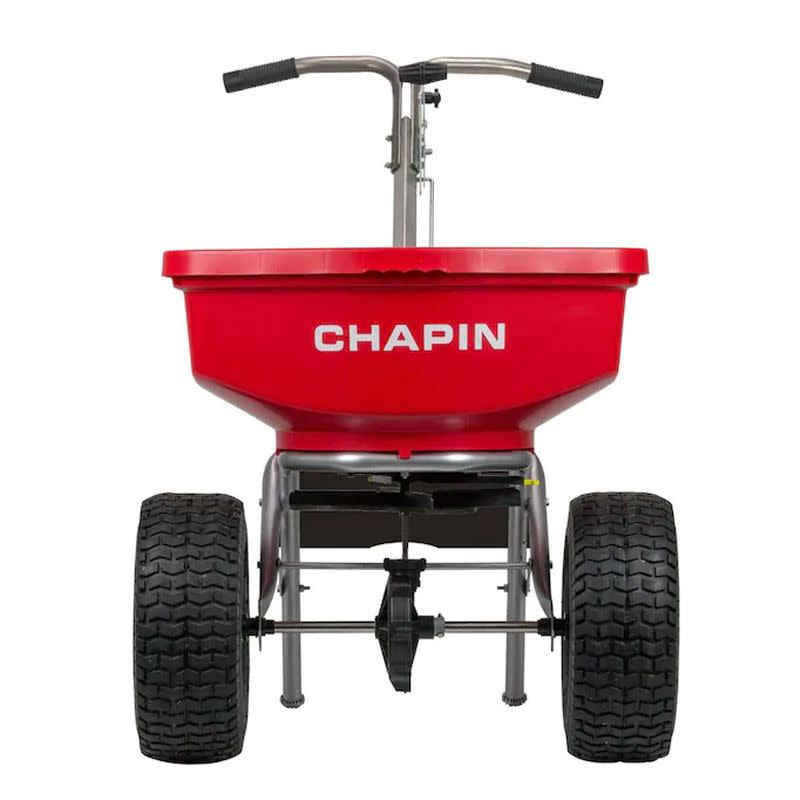
80-Pound Professional Fertilizer Spreader
lowes.com
$386.99
Turf Builder Classic Drop Spreader
If you’re looking for a more precise spread and don’t mind having to take a few extra laps to get the job done, you should go with a drop spreader like the Scott’s “Classic” here. Instead of spraying material out in three directions, it simply lays a path of seeds or fertilizer directly below it, so it doesn’t end up in places you want it, like flower beds, walkways, or a swimming pool.
There’s also a flow control adjuster on the handlebar that allows you to make minute adjustments to how much fertilizer or seed is dropped with each pass. Just be prepared to spend a little more time seeding or fertilizing.
This spreader’s 1/4-acre capacity is smaller than most, and its 22-inch wide spread pattern is a fraction of the 5-to-6-foot-wide swath you get from a broadcast spreader. But while it may take longer to get the job done, you won’t find a more precise option.

Turf Builder Classic Drop Spreader
walmart.com
$115.28
Elite Fertilizer Spreader
This Scotts broadcast spreader uses two spinning rotors to evenly spread material while you push. The dual rotors give it a broad spread pattern–up to 6 feet wide–so you can cover a lot of ground with each pass. It has incredible capacity, storing enough fertilizer or seed to treat up to 20,000 square feet.
While the plastic tires don’t have the bounce and stability of the pneumatic alternatives on other spreaders, they're broad enough to be able to move easily over small ruts or roots. Plus, you won’t have to worry about them getting punctured and deflating.
The integrated phone holder on the handle is perhaps a little gimmicky but also a nice touch. Scott’s largest broadcast spreader is a great option for those who need to fertilize a larger yard, but don’t want to spring for an expensive professional-grade option to do it.
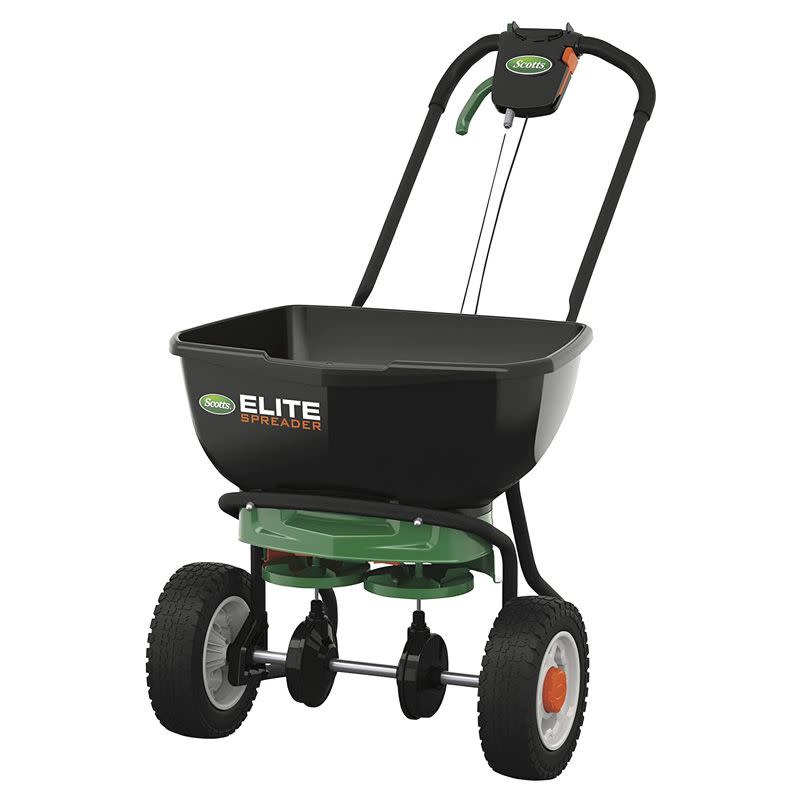
Elite Fertilizer Spreader
amazon.com
$132.79
Wizz Fertilizer Spreader
While it doesn’t have the capacity of larger walk-behind options, the battery-powered Scotts Wizz is far and away the easiest spreader to use among our picks. Just load up, grab the handle, and squeeze the trigger to spray your lawn or garden. Like our top picks from Scotts, it features EdgeGuard, which allows you to drop fertilizer or seed precisely where you want it without getting messy.
It’s one drawback is power: The Wizz requires four AA batteries, so you need to make sure to stock batteries to run it. That said, if you only have a small amount of green on your property or you’re short on space, the Wizz is a perfect handheld spreader.
Scotts also makes a handheld spreader that is manually powered. To activate it, you have to squeeze the handle trigger and turn a crank with your free hand. This is another viable option if you only have a small area you're covering and don't want to worry about whether your batteries have enough juice.
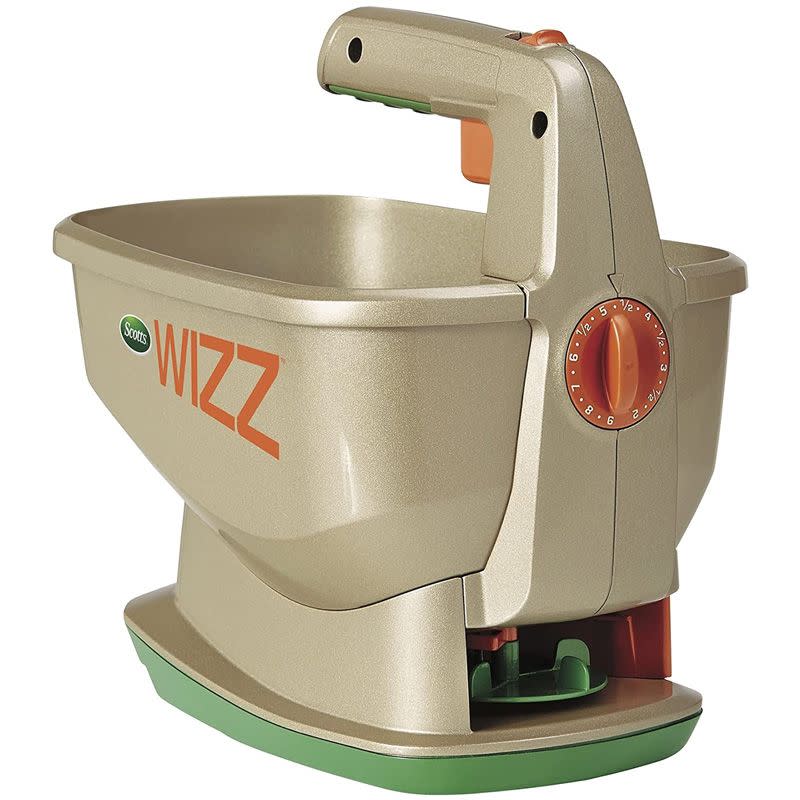
Wizz Fertilizer Spreader
lowes.com
$31.48
130-Pound Tow Fertilizer Spreader
This gigantic spreader from Agri-Fab is designed specifically for jobs that require lots of seed and fertilizer. The universal tow hitch makes it easy to connect to nearly any lawn tractor or ATV. The hopper holds 130 pounds of fertilizer, seed, or ice melt, which is enough to cover 25,000 square feet (roughly half an acre) without a refill.
Its control lever can also be reached from your mower seat, so you won’t need to stop and get off the machine to adjust the flow. If you have the need—and the heavy machinery to tow it—a huge spreader like this should save you a lot of time.
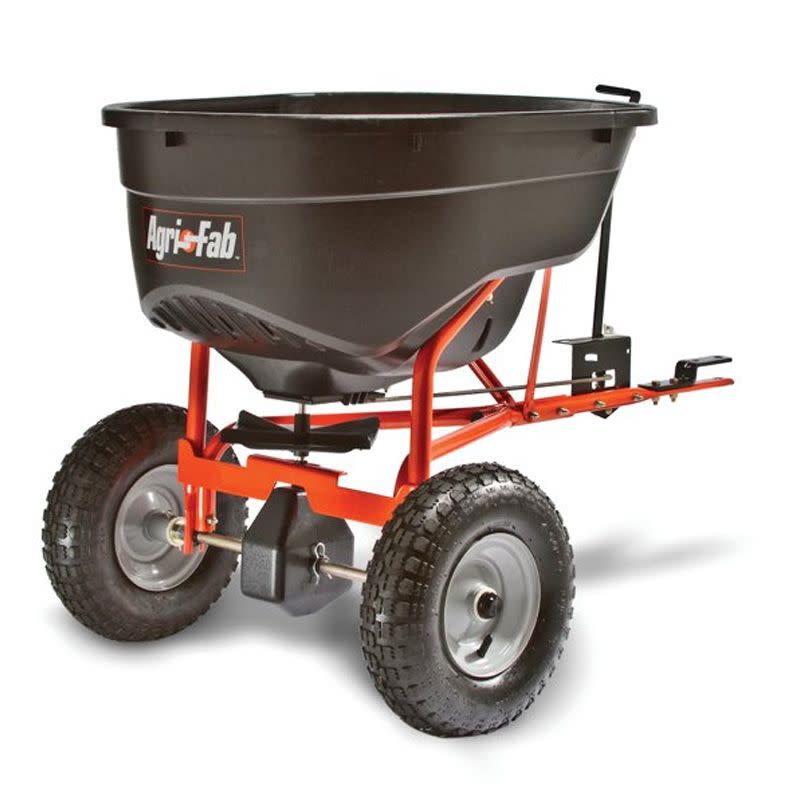
130-Pound Tow Fertilizer Spreader
walmart.com
$189.97
175-Pound Tow Drop Spreader
If you need drop spreader precision at tow-behind scale–half an acre or more–Agri-Fab also makes a massive drop spreader that’s a great choice for large properties with lots of landscaping beds, walkways, and other areas where you don’t want seed or fertilizer to end up. Hauling up to 175 pounds of material, it can cover about an acre of land on a single run.
It’s also built to last. The heavy-duty polypropylene hopper won’t rust, and its pneumatic tires should keep it stable over uneven terrain. Like the Agri-Fab broadcast tow-behind model, its control arm is positioned so the operator can reach it from the seat of a lawn tractor or ATV.
If you have a lot of ground to maintain and have a garage or shed with room for a massive spreader like this, it’s a solid choice.

175-Pound Tow Drop Spreader
amazon.com
$299.99
40 in. Tow-Behind Combination Aerator-Spreader
According to lawn care experts, it pays to aerate your yard before you fertilize. Aerating helps to loosen the soil, allowing the fertilizer (along with air and water) to reach the grass roots.
Many homeowners skip aerating because you normally need an extra heavy piece of equipment, and the extra step takes extra time. Luckily, Brinly makes a combination lawn aerator-fertilizer spreader that should cut down lawnwork by simultaneously boring holes and spreading fertilizer or seed as you tow it.
The Brinly holds up to 100 pounds of fertilizer and measures some 40 inches wide, so it’s an ideal choice for aerating, seeding, and fertilizing large yards–think half an acre or more. Just be careful about over-fertilizing: While it has controls for controlling release rate, they aren’t as user-friendly as the controls you’ll find on other spreaders.

40 in. Tow-Behind Combination Aerator-Spreader
amazon.com
$423.56
Lawn Care Tips with Gardening Expert Tony Carrick
When is the best time of year to fertilize your lawn?
You should fertilize your lawn four times a year to ensure it builds a strong root system that can endure drought, extreme temperatures, mowing, and foot traffic. Starting in the early spring, you should fertilize your lawn every 6-8 weeks. If you time it right, applications should take place in the early spring, late spring, summer, and fall. It helps to pick your fertilizer based on the season and condition of the soil each time.
Resist the urge to fertilize too frequently, even if you wind up seeding late. Adding too much fertilizer can dehydrate your grass and burn out your lawn, rather than helping it grow.
Before you fertilize, do you need to prepare your lawn in any way?
There are a few things you can do to prep your lawn for fertilizer. Start by mowing it about three or four days ahead of time. Aerating the yard beforehand will also help the fertilizer better reach your grass’ roots. Consider dethatching your lawn ahead of time, as well, if there’s a heavy layer of thatch —essentially dead grass — underneath. Finally, give the lawn a good watering the night before you fertilize.
What should you do after fertilizing?
After you apply the fertilizer, wait 24 hours to allow it to settle into the lawn, then give it a thorough watering. The water will activate the fertilizer and allow it to better absorb into the soil. Watering will also prevent the fertilizer from burning individual blades of grass.
If possible, we recommend waiting until the day after that first watering before you let your kids, pets, or anyone else walk on your freshly fertilized yard.
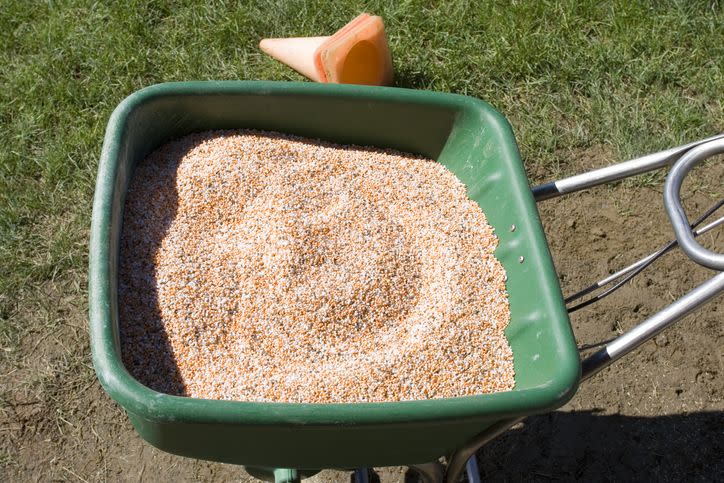
You Might Also Like

